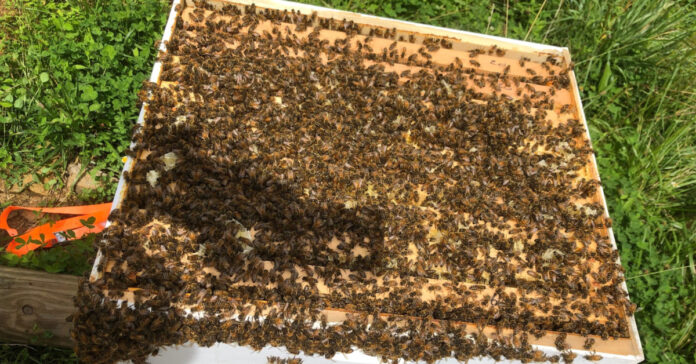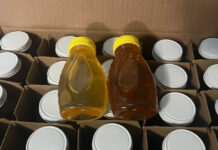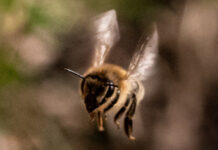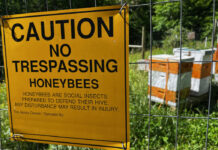
I spent about five hours in a bee suit today, checking hives and harvesting honey. Very sweaty business. I changed baseball caps once, drank two big mugs of ice water, and used two sweat towels. After I showered up, I weighed myself and I had lost almost two pounds. Despite it being hot out there in the full sun, it was cooler than last week. I know much of the country is broiling, but we’re in the low 80s.
The good news is that I harvested twice as much honey as I did four weeks ago, and I left plenty of partially capped frames in the hives. I am going to run out of bottles and jars. I’ll update you after I extract it all, but I am anticipating 75 pounds of honey, which will put us over 110 pounds for the year. That’s far more than I had hoped for. Plus, we’ll do one last harvest in late August. I hope that will be our biggest harvest and put us at 200 to 250 pounds for the year. I will have to assemble my remaining supers by then.
We’re already selling some honey to people who buy our eggs, but we have far more honey than eggs. I’ve also got some for sale in local stores. It’s been a good spring for honey, so there are other local honey sellers out there. However, if I can sell 100 or more pounds at $12 or $15 a pound, it would make a nice dent in my beekeeping expenses. I know local honey often sells out, so I may keep some back and sell it in the fall and winter.
I expect to spend the next day extracting and filtering honey and the day after that bottling and then cleaning up.
A Bee Surprise
One hive I opened surprised me. There was brood in a super above the queen excluder. I feared this meant she had snuck through the excluder, but there was no brood below. She must have somehow gotten into the supers the last time I opened the hive, which was two weeks ago. While there were three supers, she had only laid eggs in one. Unfortunately, she had laid eggs in our foundationless frames, which means we won’t be eating comb honey from them.
I removed the queen excluder and reassembled the hive. Crossing my fingers that the next time I open it I find eggs and larvae so I know she is laying.
Trees
This is not the only job I tackled this past week. Once it stopped raining, my wife and started killing off all the newly sprouted Tree of Heaven trees, which is highly invasive and will take over your landscape, forcing out native plants. It is also the preferred host for the spotted lantern fly (a dangerous invasive insect), which we don’t have in this area and we don’t want!
We also evaluated our “vertical meadows,” which is what I call the steep slopes of our mountain that are not forested. We decided to keep a few of the many young trees on these sloped and then we clipped, snipped, chopped or sawed down the countless saplings and yanked out seedlings. Most of them were tulip poplar and locust, but there were some birch and a few maples. I believe they were all less than three years old, but they have taken off this year. As much as we like to have their root stabilizing the steep slope, we’d rather have the items we planted and the many wild flowers and flowering weeds that grow there. Besides, there is no shortage of these trees in the thousands of acres around us.
Once we cut them off the sapling, we carefully dribble a little Round-Up on the stem to keep them from growing up again. While we try to minimize herbicide use, we’ve found conditions at our location to so prolific, it’s the only thing that keeps trees and other plants from growing where you don’t want them.
Our burn pile grows with every passing week.
Garden Harvest
Our Swiss chard is huge, despite cutting it back and eating it. We end up feeding some of the excess to the chickens. Of course, Swiss chard and leafy greens will not sustain us. I expect to harvest some potatoes soon, which would provide more calories. It will be interesting to see if they are “new” potatoes or full-grown. That will determine when I harvest the rest. We have also harvested all the tomatoes from the plant a neighbor gifted us.
Something that ate holes in its leaves overran the cabbage. We saved two. One other was so bad it went straight to the chickens. The final cabbage may as well.
The summer squash and zucchini are looking pretty strong and they are showing some blooms. Our cucumbers are behind them.
No sign of all the sunflower seeds I planted. We may not know if we have any sunflowers until they form seed heads and start to bloom. There are tall plants growing in the general area where I planted some, but they could just be giant weeds. Yes, we get weeds like goldenrod that grow to five and sex feet tall. Our bees love goldenrod and as a late bloomer, it gives them plenty of resources to harvest and store for the winter.
My wife laughs at me since I did not plant the sunflowers in a special bed. Because we had no beds left, I planted them in random locations all over our meadows and on both sides of the driveway. I have some candidate plants I think are sunflowers, but it remains to be seen.
Fresh Berries
We are in the middle of the blackberry harvest and yesterday I ate my fill and froze a couple pints worth. I may make blackberry ham, possibly sweetened with honey. Our neighbor’s blue berries should be ripe soon as well.
What I believe to be raspberries have bloomed but not yet set fruit. This is a surprise to me since as a kid we harvested wild raspberries over the Fourth of July weekend. Besides those on our land, we have seen some in the wilderness areas around us.
The apples trees in the area have plenty of fruit. I like to think my bees helped with pollination.
The good news is, we are continuing to learn about what grows in this area, what the natural cycles and rhythms are, and what we need to do to improve our soil (it needs nitrogen) and control pests.








Nice newsy interesting piece in a time of great frustration. Thanks
this has been a strange year here in Ga. colder than normal spring. planted tomatoes and cantaloupe later than normal. and harvested earlier. tomato season is already over normally it ends the beginning of August. cantaloupes usually aren’t ready until end of July. I am getting my last succession of them now.. weird year.
Comments are closed.